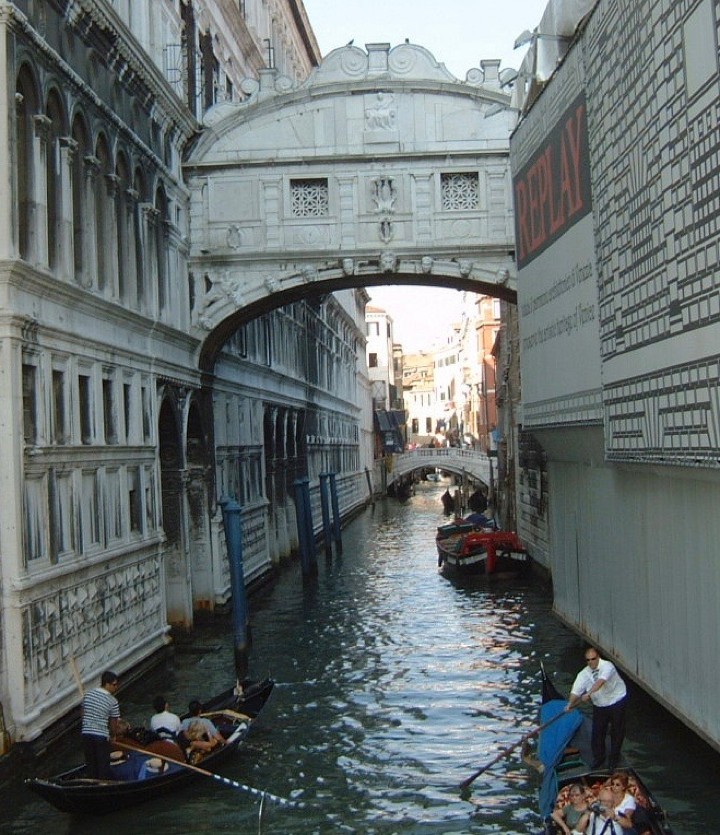BY JANET STEINBERG
“I want to be the bridge to the next generation”
Michael Jordan
BRIDGE? What is a bridge?
A bridge can
be different things to different people. It can be a ship’s
control room…an understanding between people…the closing of a generation
gap…a means of approach…the top of a nose…or even a partial plate of false
teeth. However, the bridges that fascinate me the most are those structures
that allow passage across an obstacle. We walk on some, we drive on some, we
sail under some and we even shop on some.
be different things to different people. It can be a ship’s
control room…an understanding between people…the closing of a generation
gap…a means of approach…the top of a nose…or even a partial plate of false
teeth. However, the bridges that fascinate me the most are those structures
that allow passage across an obstacle. We walk on some, we drive on some, we
sail under some and we even shop on some.
In some
respects, bridges are like people. They have personalities and even
nicknames such as The Swinging Queen, The Comb and The Coathanger. They
personify the imagination, the architecture and the art of a city. Next
time you approach a bridge, don’t just walk on it or drive across it. Be
sure to look at it…I mean really look at it! When I finally took a good
look at a bridge that had been in my Cincinnati hometown for decades before I
was born, I realized there was a treasure approximately one mile from my
home. Please allow me to share with you my hometown treasure and some
other architectural gems from around the world.
respects, bridges are like people. They have personalities and even
nicknames such as The Swinging Queen, The Comb and The Coathanger. They
personify the imagination, the architecture and the art of a city. Next
time you approach a bridge, don’t just walk on it or drive across it. Be
sure to look at it…I mean really look at it! When I finally took a good
look at a bridge that had been in my Cincinnati hometown for decades before I
was born, I realized there was a treasure approximately one mile from my
home. Please allow me to share with you my hometown treasure and some
other architectural gems from around the world.
JOHN A.
ROEBLING SUSPENSION BRIDGE, CINCINNATI, OHIO: When
the first pedestrians crossed the John
A. Roebling Suspension Bridge in 1866, it was the longest
suspension bridge in the world. Spanning the Ohio River from
Covington, Kentucky to Cincinnati, Ohio, the bridge is also used by pedestrians
who walk between the two states for entertainment and sports venues on both
sides of the river. The bright blue color of the bridge, affectionately
dubbed “Kentucky Blue” was said to have influenced Daniel Libeskind’s choice
of blue glass for his adjacent condominium, The Ascent at Roebling’s Bridge.
The Roebling Suspension Bridge was listed on the National Register of Historic
Places in 1975 and designated a National Historic Civil Engineering
Landmark in 1983.
ROEBLING SUSPENSION BRIDGE, CINCINNATI, OHIO: When
the first pedestrians crossed the John
A. Roebling Suspension Bridge in 1866, it was the longest
suspension bridge in the world. Spanning the Ohio River from
Covington, Kentucky to Cincinnati, Ohio, the bridge is also used by pedestrians
who walk between the two states for entertainment and sports venues on both
sides of the river. The bright blue color of the bridge, affectionately
dubbed “Kentucky Blue” was said to have influenced Daniel Libeskind’s choice
of blue glass for his adjacent condominium, The Ascent at Roebling’s Bridge.
The Roebling Suspension Bridge was listed on the National Register of Historic
Places in 1975 and designated a National Historic Civil Engineering
Landmark in 1983.
 |
| ROEBLING’S BLUE SUSPENSION BRIDGE ADJACENT TO LIBESKIND’S BLUE-GLASSED ASCENT. |
QUEEN
EMMA BRIDGE, CURACAO: She’s
“The Swinging Queen”. No,
you’re not hearing the words of a new ABBA song, nor are you reading the title
of a hit tune in a “Mamma Mia” sequel. This Swinging Queen is Queen Emma,
Willemstad’s famous 19th-century pontoon bridge that, without saying a word,
shouts “bon-bini” (welcome) to Curacao. Queen Emma may be old and pudgy,
but Queen Emma still swings. This venerable old lady, taking it somewhat
easier in her late years, is now closed to vehicular traffic and has become a
giant floating sidewalk for pedestrians. The floating Queen Emma pontoon
bridge splits Curacao’s capital city of Willemstad into two neighborhoods: Otrobanda
(which literally means “the other side”) and Punda, the side
more known to tourists.
EMMA BRIDGE, CURACAO: She’s
“The Swinging Queen”. No,
you’re not hearing the words of a new ABBA song, nor are you reading the title
of a hit tune in a “Mamma Mia” sequel. This Swinging Queen is Queen Emma,
Willemstad’s famous 19th-century pontoon bridge that, without saying a word,
shouts “bon-bini” (welcome) to Curacao. Queen Emma may be old and pudgy,
but Queen Emma still swings. This venerable old lady, taking it somewhat
easier in her late years, is now closed to vehicular traffic and has become a
giant floating sidewalk for pedestrians. The floating Queen Emma pontoon
bridge splits Curacao’s capital city of Willemstad into two neighborhoods: Otrobanda
(which literally means “the other side”) and Punda, the side
more known to tourists.
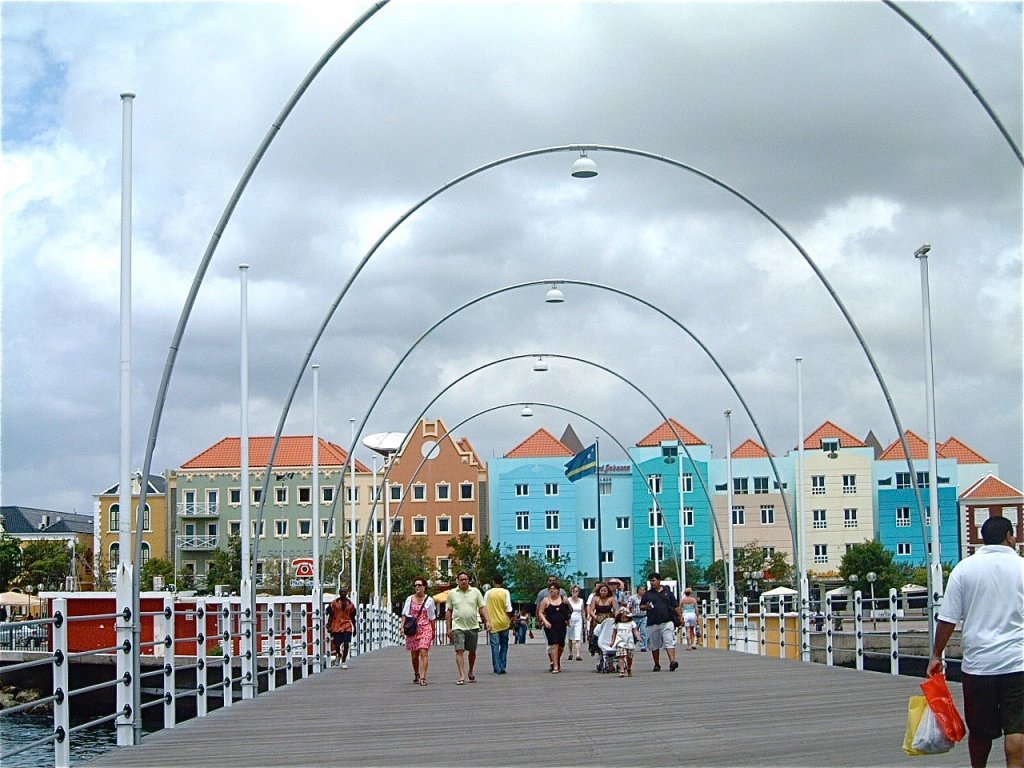 |
|
QUEEN EMMA, THE SWINGING QUEEN |
ALAMEDA
BRIDGE, VALENCIA, SPAIN: Also
known as the Pont de l”Exposicio, the Alemeda Bridge, completed in
1995, spans the dry Turia river bed in Valencia, Spain. It has also been
nicknamed “Peineta”, the Spanish word for the decorative combs
Spanish women wear in their hair. Designed by Valencian
architect”Santiago Calatrava, the 535-foot bridge connects the city center with
the university district. The Alameda Metro Station, also designed by
Calatrava, is beneath the bridge.
BRIDGE, VALENCIA, SPAIN: Also
known as the Pont de l”Exposicio, the Alemeda Bridge, completed in
1995, spans the dry Turia river bed in Valencia, Spain. It has also been
nicknamed “Peineta”, the Spanish word for the decorative combs
Spanish women wear in their hair. Designed by Valencian
architect”Santiago Calatrava, the 535-foot bridge connects the city center with
the university district. The Alameda Metro Station, also designed by
Calatrava, is beneath the bridge.
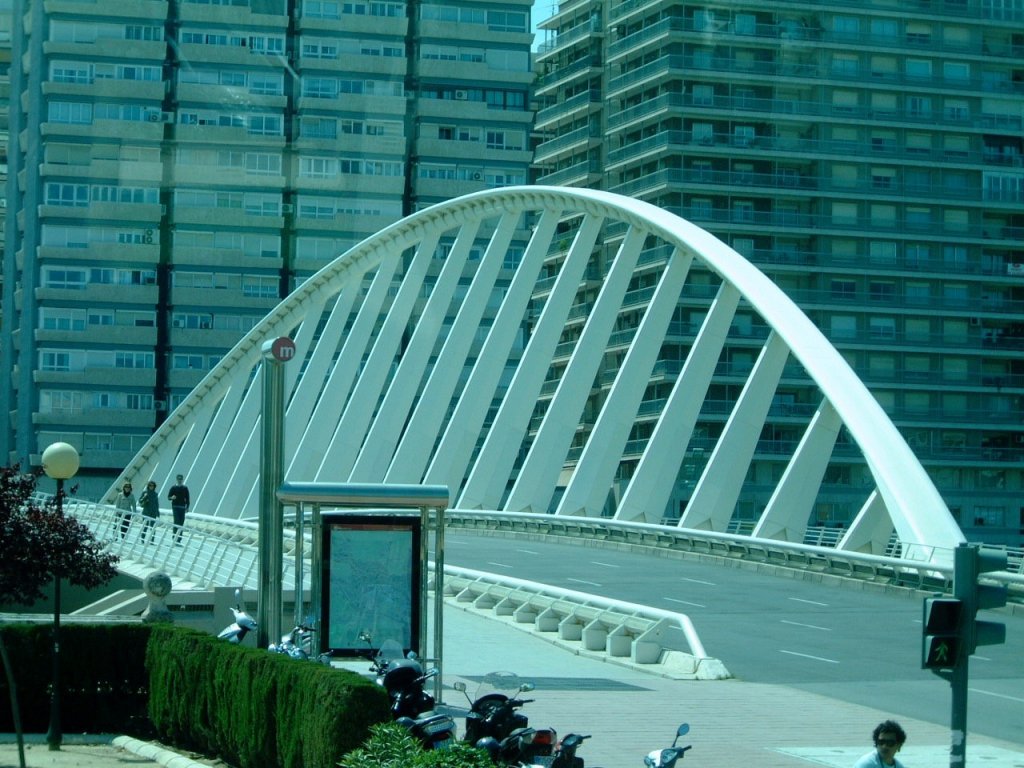 |
| CALATRAVA’S ALAMEDA BRIDGE |
BRIDGE OF SIGHS,VENICE, ITALY: The only covered bridge in Venice, this tiny baroque bridge is made of white limestone with windows that have stone bars. Built in
1600, the bridge was used to move criminals from the ground floor of
the Doge’s Palace to a building directly across a narrow canal from
the Palace. In the 19th century, Lord Byron translated the
Italian name Ponte dei Sospiri to Bridge of Sighs. Folklore
surrounds the Bridge of Sighs. One tale has it that the name came from the
sighs of prisoners sentenced to life in the new prison as they took in their
last view of Venice from the tiny windows in the bridge. Another,
possibly spread by the gondoliers, says if you kiss your love beneath the
bridge at sunset, your love will last forever.
1600, the bridge was used to move criminals from the ground floor of
the Doge’s Palace to a building directly across a narrow canal from
the Palace. In the 19th century, Lord Byron translated the
Italian name Ponte dei Sospiri to Bridge of Sighs. Folklore
surrounds the Bridge of Sighs. One tale has it that the name came from the
sighs of prisoners sentenced to life in the new prison as they took in their
last view of Venice from the tiny windows in the bridge. Another,
possibly spread by the gondoliers, says if you kiss your love beneath the
bridge at sunset, your love will last forever.
SOMERSET
BRIDGE, BERMUDA: Somerset Bridge, originally built in 1620 (and cranked open by hand in those
days) connects
Somerset Island with Sandys Parish on the Bermuda mainland. Measuring a mere 32 inches
wide, it is
reputedly the smallest working drawbridge in the world. Today, two
cantilevered half-spans are separated by an 18-inch gap and bridged by a
thick timber panel that must be removed whenever a yacht wishes to pass
beneath the bridge. This allows the mast of the yacht to
pass through the gap.
BRIDGE, BERMUDA: Somerset Bridge, originally built in 1620 (and cranked open by hand in those
days) connects
Somerset Island with Sandys Parish on the Bermuda mainland. Measuring a mere 32 inches
wide, it is
reputedly the smallest working drawbridge in the world. Today, two
cantilevered half-spans are separated by an 18-inch gap and bridged by a
thick timber panel that must be removed whenever a yacht wishes to pass
beneath the bridge. This allows the mast of the yacht to
pass through the gap.
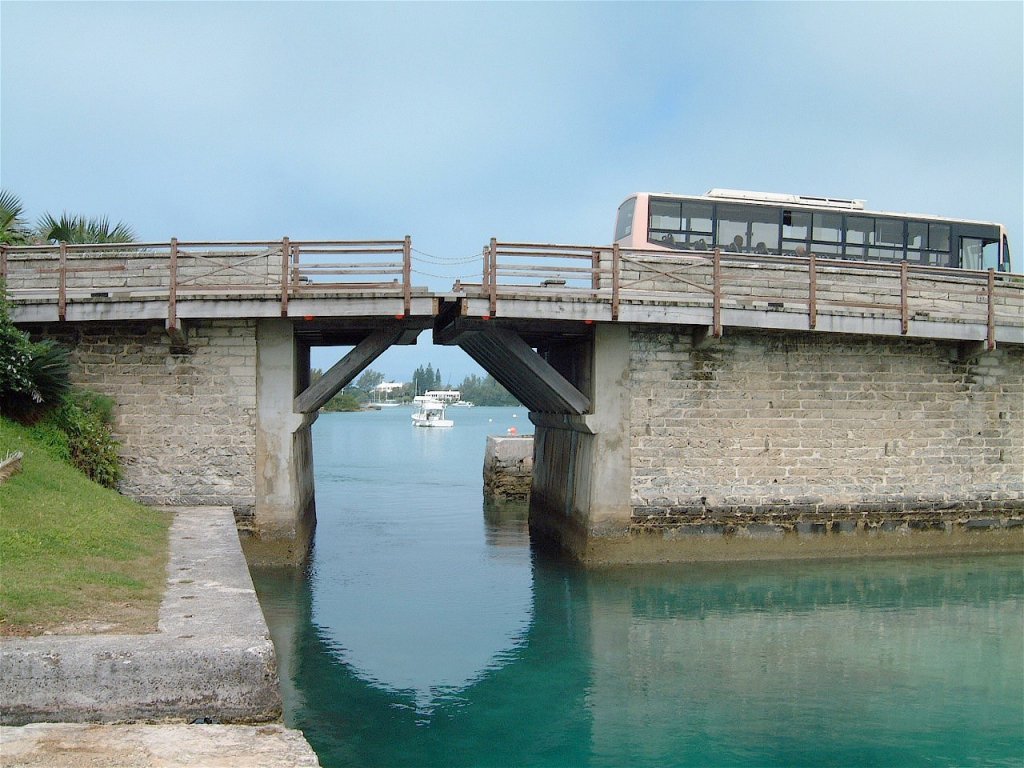 |
| SOMERSET BRIDGE IS SAID TO BE THE SMALLEST DRAWBRIDGE IN THE WORLD |
WOMAN’S BRIDGE, BUENOS AIRES, ARGENTINA: Puente De La Mujer,
as it is called in Buenos Aires, is a rotating footbridge in the Puerto
Madero commercial district of Buenos Aires, Argentina. The bridge got
its name because many streets in the Puerto Madero district have women’s names.
Cables connected to a single mast suspend a part of the bridge that
rotates 90 degrees. When the bridge swings to let a ship pass, the far
end rests on a stabilizing pylon. The architect, Santiago Calatrava
described his design “as a synthesis of the image of a couple dancing the tango
as it is called in Buenos Aires, is a rotating footbridge in the Puerto
Madero commercial district of Buenos Aires, Argentina. The bridge got
its name because many streets in the Puerto Madero district have women’s names.
Cables connected to a single mast suspend a part of the bridge that
rotates 90 degrees. When the bridge swings to let a ship pass, the far
end rests on a stabilizing pylon. The architect, Santiago Calatrava
described his design “as a synthesis of the image of a couple dancing the tango
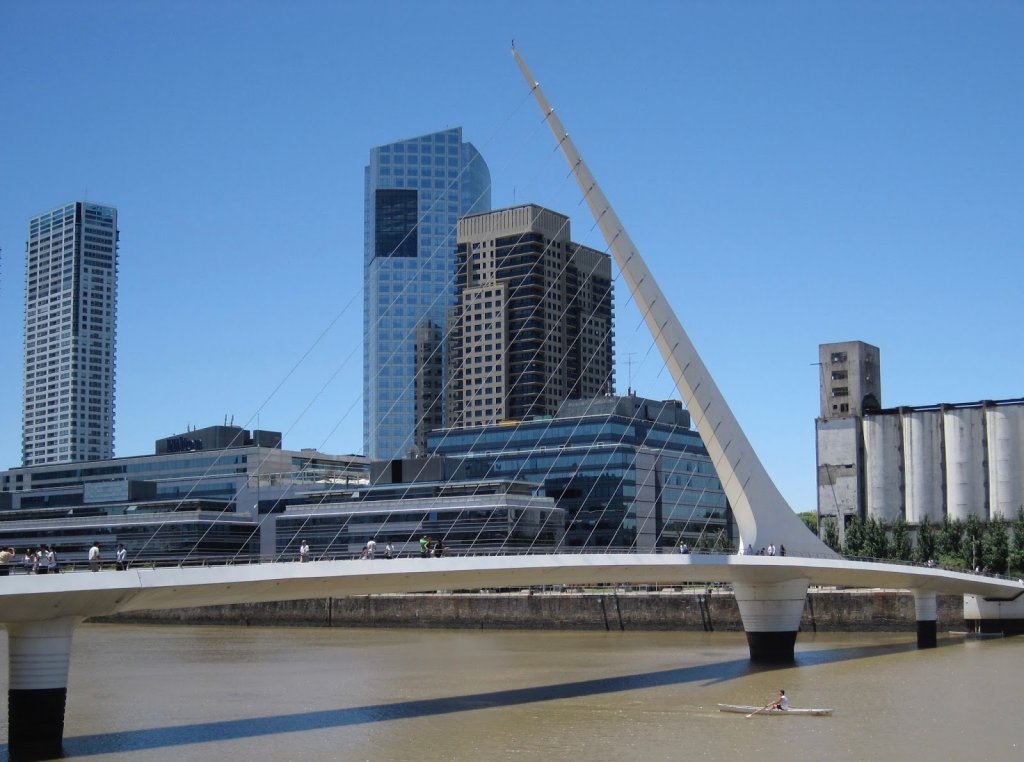 |
| THE WOMAN’S BRIDGE |
PONTE VECCHIO, FLORENCE,
ITALY: Crossing the Arno River on the medieval stone Ponte
Vecchio (Old Bridge) may be most expensive bridge crossing you ever
make. No, this oldest bridge, opened in 1345, is not a toll bridge.
It is a bridge that glistens from the gold baubles lining the windows of the
jewelry stores that once were butcher shops. It’s hard to resist the urge
to purchase a bauble. The butchers were forced to leave their bridge shops
by Grand Duke Ferdinando 1, who didn’t like the noise or the odor created by
their trade. The fourteenth century Ponte Vecchio, is the only bridge in
Florence that was not blown up during World War II. Although severely damaged when the Arno flooded in 1966,
the bridge miraculously withstood the tremendous weight of the silt and the
water.
ITALY: Crossing the Arno River on the medieval stone Ponte
Vecchio (Old Bridge) may be most expensive bridge crossing you ever
make. No, this oldest bridge, opened in 1345, is not a toll bridge.
It is a bridge that glistens from the gold baubles lining the windows of the
jewelry stores that once were butcher shops. It’s hard to resist the urge
to purchase a bauble. The butchers were forced to leave their bridge shops
by Grand Duke Ferdinando 1, who didn’t like the noise or the odor created by
their trade. The fourteenth century Ponte Vecchio, is the only bridge in
Florence that was not blown up during World War II. Although severely damaged when the Arno flooded in 1966,
the bridge miraculously withstood the tremendous weight of the silt and the
water.
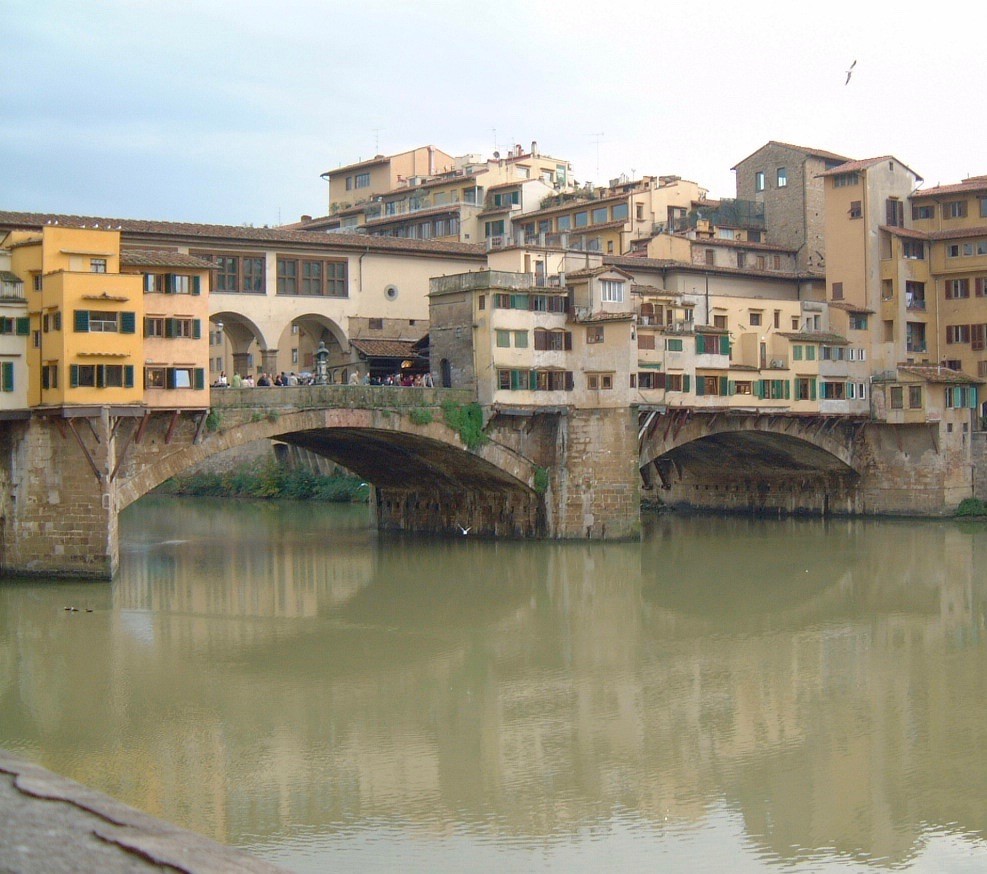 |
| PONTE VECCHIO REFLECTED IN THE ARNO RIVER |
Wherever your
travels…or your life… may take you, cross that bridge! You never know
what you’ll find on the other side.
travels…or your life… may take you, cross that bridge! You never know
what you’ll find on the other side.
TEXT AND
PHOTOS by JANET STEINBERG.
PHOTOS by JANET STEINBERG.
STEINBERG
is the winner of 43 national Travel Writer Awards. She is also a Travel
Consultant with The Travel Authority in Cincinnati, Ohio
is the winner of 43 national Travel Writer Awards. She is also a Travel
Consultant with The Travel Authority in Cincinnati, Ohio

